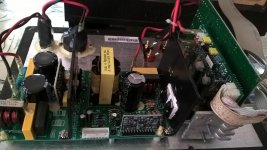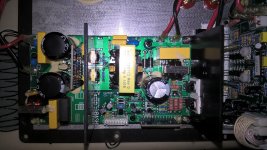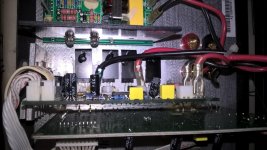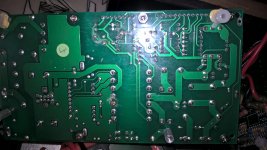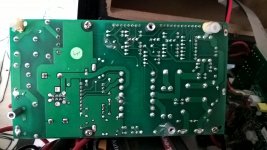SHOULD READ DEAD SMPS!
My son bought a dead Klipsch Subwoofer recently with SMPS. I did some simple testing and found that there was no positive supply reaching the amp board. There is a 7815 and 7915. I assumed the 7815 was dead and replaced it (although it looked ok) still no POS supply, so there is something gone on the SMPS board. Having Googled it seems that this is not uncommon. The board is made by BASH who make plate amps and some have bought one of these simply to replace the SMPS which is identical. However these of course have failed too.
It seems that the required voltages are +24v/-24v and 3.3v. I have thought about making a linear supply with appropriate transformer. What puzzles me is why there appears to be so much circuitry on the SMPS just to provide a couple of voltages.Are these for current limiting/short circuit protection or such like.
Would I be wasting my time? Trying to fix the SMPS would be beyond my capabilities as I have no test equipment.
My son bought a dead Klipsch Subwoofer recently with SMPS. I did some simple testing and found that there was no positive supply reaching the amp board. There is a 7815 and 7915. I assumed the 7815 was dead and replaced it (although it looked ok) still no POS supply, so there is something gone on the SMPS board. Having Googled it seems that this is not uncommon. The board is made by BASH who make plate amps and some have bought one of these simply to replace the SMPS which is identical. However these of course have failed too.
It seems that the required voltages are +24v/-24v and 3.3v. I have thought about making a linear supply with appropriate transformer. What puzzles me is why there appears to be so much circuitry on the SMPS just to provide a couple of voltages.Are these for current limiting/short circuit protection or such like.
Would I be wasting my time? Trying to fix the SMPS would be beyond my capabilities as I have no test equipment.
Last edited by a moderator:
I am looking to try a linear PS. The schematic for this amp does not show the voltage for the PWM or Bulk Monitoring feeds. When checking the voltages I got -3.3v on the multi-pin connector from the PS board to the amp board. Would this be the feed for the PWM circuit? Any ideas as to the bulk monitoring voltage?
A picture of the board would help but generally most SMPS are similar and often appearing fairly complex. Some SMPS are just notoriously unreliable (as in poor design) rather than having a basic fault caused by an underspecified part or whatever. Not saying that's the case here but it happens.
Photobucket is no good:
Photobucket yanking (free) inline img hosting
Just attach them to the forum, its much quicker.
Photobucket yanking (free) inline img hosting
Just attach them to the forum, its much quicker.
Pics are fine, but for any meaningful answer, we actually need the schematics.
search and post them here.
Yes, I have one.
If you find a voltage on the connector, are you shure the SMPS is outWhen checking the voltages I got -3.3v on the multi-pin connector from the PS board to the amp board.
Mona
I had more time than I thought. Let me know if you need any more photos
Attachments
Looking at the circuit and it seems quite a convoluted PSU tbh.
First checks would have to be the usuals of seeing if either of the switching transistors on the primary side are shorted (Q401/402). I would be deeply suspicious of those Junzl caps (and others). The UC3842 control chip has been around for decades and typically gets taken out along with the transistors.
Also check for shorted diodes in the PSU... but working on these is pretty advanced faultfinding and there are hidden dangers as much of the circuitry is always live. Note the different ground symbols, they all mean different things.
First checks would have to be the usuals of seeing if either of the switching transistors on the primary side are shorted (Q401/402). I would be deeply suspicious of those Junzl caps (and others). The UC3842 control chip has been around for decades and typically gets taken out along with the transistors.
Also check for shorted diodes in the PSU... but working on these is pretty advanced faultfinding and there are hidden dangers as much of the circuitry is always live. Note the different ground symbols, they all mean different things.
Personally I wouldn´t touch it and I have been building (analog) amplifiers and supplies for over 40 years.
Plus the main question remains: supposing a conventional (large iron/diodes/large capacitors) suitable voltage supply can be built ... what if it´s the amplifier who´s dead?
The power supply short protection might simply be doing its job, shutting it off (except, maybe, the 3V3 "logic" rail).
I am into Musical Instruments and Live Sound professionally, and something which I am starting to see all over the place: small bands / Clubs / rehearsal spaces ... even small Churches or Sound Operators is that I see different brand ubiquitous powered cabinets, typical "EON type", single 15" (or 12") woofer + molded large mid/high horn inside a plastic molded cabinet .... when I look behind I am *amazed* to find, instead of the customary plate amp, often with Line/mic inputs and some controls, just a flat plywood rectangle cut to fit and cover the gaping hole, or even the original aluminum plate (even with attached finned heatsink :O ) but with all controls, switches, connectors, knobs pulled and a couple Speakon connectors mounted there.
And such cabinets get driven by external low cost (or bought used) Rack type power amps, period.
Not a bad idea to reuse them instead of junking them, I guess you might try to find a subwoofer plate amp (lots available for very reasonable price) and fit it there or plain cover the hole as mentioned and use an external power amp.
Plus the main question remains: supposing a conventional (large iron/diodes/large capacitors) suitable voltage supply can be built ... what if it´s the amplifier who´s dead?
The power supply short protection might simply be doing its job, shutting it off (except, maybe, the 3V3 "logic" rail).
I am into Musical Instruments and Live Sound professionally, and something which I am starting to see all over the place: small bands / Clubs / rehearsal spaces ... even small Churches or Sound Operators is that I see different brand ubiquitous powered cabinets, typical "EON type", single 15" (or 12") woofer + molded large mid/high horn inside a plastic molded cabinet .... when I look behind I am *amazed* to find, instead of the customary plate amp, often with Line/mic inputs and some controls, just a flat plywood rectangle cut to fit and cover the gaping hole, or even the original aluminum plate (even with attached finned heatsink :O ) but with all controls, switches, connectors, knobs pulled and a couple Speakon connectors mounted there.
And such cabinets get driven by external low cost (or bought used) Rack type power amps, period.
Not a bad idea to reuse them instead of junking them, I guess you might try to find a subwoofer plate amp (lots available for very reasonable price) and fit it there or plain cover the hole as mentioned and use an external power amp.
Last edited:
If any of +/-15V rails missing:
- Check R421. The same winding provides input to +15 and -15V regulators. This resistor acts like a fuse for both rails. If resistor is open find the short elsewhere that caused overcurrent.
- Check C418,C419 in power supply for reduced capacitance. Also check C118,C119 in amp board.
- If any of these are dry, check for reduced capacitance (and increased ESR) all small electrolytics in the circuit subject to some ripple current, for example C426 in PSU board.
Recommended replacement for these small straight electrolytics are Aluminum Polymer electrolytics. Personally I no longer use small straight electrolytic capacitors, there are ceramics and Alum-Polys that last much longer.
And standard safety guidelines, isolation transformer and variac are recommended. Be careful with live primary side when testing.
- Check R421. The same winding provides input to +15 and -15V regulators. This resistor acts like a fuse for both rails. If resistor is open find the short elsewhere that caused overcurrent.
- Check C418,C419 in power supply for reduced capacitance. Also check C118,C119 in amp board.
- If any of these are dry, check for reduced capacitance (and increased ESR) all small electrolytics in the circuit subject to some ripple current, for example C426 in PSU board.
Recommended replacement for these small straight electrolytics are Aluminum Polymer electrolytics. Personally I no longer use small straight electrolytic capacitors, there are ceramics and Alum-Polys that last much longer.
And standard safety guidelines, isolation transformer and variac are recommended. Be careful with live primary side when testing.
Last edited:
Plus the main question remains: supposing a conventional (large iron/diodes/large capacitors) suitable voltage supply can be built ... what if it´s the amplifier who´s dead?
The power supply short protection might simply be doing its job, shutting it off (except, maybe, the 3V3 "logic" rail).
A very valid point actually.
Well, lots to consider and to check. Thank you all for your input. Mooly and Eva, I will test the parts you have flagged up and report back. Should I remove them to test, or can it be done in circuit and should it powered up. I have a lightbulb tester which has been invaluable.
Low ohmic resistors you can test in circuit but capacitors have to come out.Should I remove them to test, or can it be done in circuit and should it powered up.
A light bulb doesn't protect YOU,an isolation transformer does (to a certain extend).I have a lightbulb tester which has been invaluable.
The SMPS is of the self osillating kind (like in electronic TL-ballasts and halogeen transformers).It stops if the load is to heavy.
But first check if there is live after the rectifier bridge on the line input.
Also check the diodes (in circuit, power off) D405 ... 409 for shorts.
Mona
The point JMF raised reminds me how useful it was to separate the amp from an SMPS I fixed last year. An amp fault was dragging it down and gave very misleading symptoms fault finding the SMPS - which also had a fault. I attached a dummy load which helped hugely. And I'd never have fixed it without a VARIAC. I had a simple open circuit resistor to find to fix that PS after replacing a few blown parts. Good luck.
Shorted transistors and diodes will show in circuit although be aware that some of the large high speed diodes could well have lower than usual forward volt drops meaning that a DVM on diode range would show lower than the normal 600/700 reading.
Also make sure the reservoir caps are not holing any charge before handing the board. Measure the voltage across them and make sure its near zero (or a few volts at most).
Also make sure the reservoir caps are not holing any charge before handing the board. Measure the voltage across them and make sure its near zero (or a few volts at most).
- Status
- This old topic is closed. If you want to reopen this topic, contact a moderator using the "Report Post" button.
- Home
- Amplifiers
- Power Supplies
- Dead SMPS
